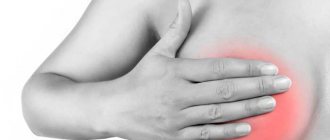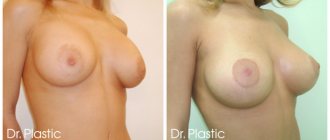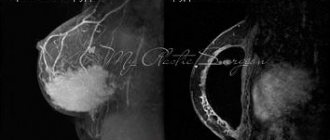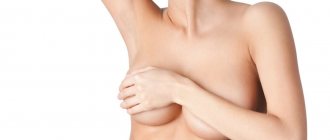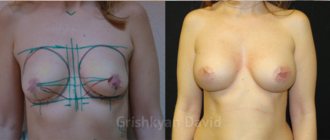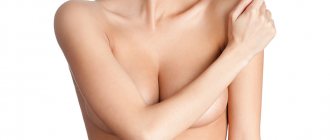Dreaming of quickly seeing the final result after mammoplasty, the patient may encounter such a phenomenon as ripple. This is a complication that manifests itself in irregularities and grooves that arise due to insufficient volume of skin tissue covering the implant. If you look at the photos before and after mammoplasty, you can see that this defect is located along the contour of the mammary glands and looks as if they ran their fingers across the breast, leaving unaesthetic grooves. Essentially, this is a visual manifestation of the implant after breast augmentation surgery. The defect may be invisible, or it may appear when a woman bends her body forward or walks. It also happens that visually the ripples are almost invisible, but are felt only when moving your hand. Many women do not consider this effect a complication at all, but for others it is a problem, for the elimination of which they are ready to once again go under the knife of a plastic surgeon.
Definition
Ripping after mammoplasty is a complication characterized by the formation of small folds, “waves” or “ripples” on the breast.
It represents a visual manifestation of the implant.
When the implant is positioned vertically, its upper part rolls into the lower part, and folds form at the top (typical of saline implants). When the skin is over-tensioned, these folds begin to appear.
Ripping may not appear when the glands are in a quiet position and can only be detected when the body is tilted or while walking.
A defect can occur due to the physiological characteristics of the body, insufficient volume of skin, incorrectly selected implants, violation of surgical technique, etc.
The likelihood of ripping directly depends on the size of the selected implants. The larger they are, the sooner a defect will occur.
Other consequences
Lipofilling does not provide lifelong results, since adipose tissue is absorbed over time in any case. The resorption period is individual and depends on the specific characteristics of the body. The optimal period for maintaining the result is 5-10 years.
But in very rare cases, resorption of the transplanted material is possible within a couple of months after correction. This does not depend in any way on the skill with which the operation was performed, or on the patient’s self-care during the rehabilitation period. These are the very individual characteristics of the body that cannot be influenced.
After the intervention, cysts are highly likely to form in varying numbers. In the future, these cysts can become a source of concern for both the patient and her mammologist.
Also after surgery, minor bruising, swelling, and decreased sensitivity may occur. These are not complications after breast lipofilling, but a personal reaction of the body in response to the intervention. As a rule, it goes away in a few days. If the rate of bruising and swelling is prolonged, it makes sense to consult your doctor.
Why does it appear
Often, a similar effect appears after surgery, when the swelling subsides, but the skin still remains stretched, poorly contracted and gathers in folds. In this case, implants have nothing to do with it; this is a temporary phenomenon.
There are several factors that influence the risk of this complication:
- volume and elasticity of the skin and soft tissues;
- type and size of implant;
- place and technique of administration.
“Waves” most likely will not appear or will be barely noticeable if the volume of the skin is sufficient to properly cover the implant.
This is why ripping appears more often in petite women with a thin layer of fat and small mammary glands.
In obese patients with a pronounced layer of subcutaneous fat and initially voluminous breasts, this problem, on the contrary, does not exist.
In general, it is believed that the more implants are selected, the higher the risk of ripping.
The location of the prosthesis plays an important role. Submuscular placement of the implant (i.e., under the muscle) is preferable.
Thanks to this, a larger volume of soft tissue is formed over the prosthesis, and the muscles themselves have their own tone, which also helps hide the defect.
Since the muscle only covers half or 2/3 of the top of the implant, it is still possible for ripples to form in the area of the lower gland fold.
Photo: Ripling
But this place itself is hardly noticeable, and even with deep probing you can feel something, but not see anything special. That is why a little ripping is perceived quite normally here.
The pectoral muscles are usually well developed in the center and become thinner and flatter towards the outer border of the rib cage.
Therefore, when the prosthesis is inserted under the muscle, the outer edge of the tissue volume may not be enough, and ripples from the side become noticeable (especially when bending). If such a defect is unacceptable, you will have to opt for smaller implants.
Ideally, the width of the prosthesis should be less than the diameter of the mammary glands before mammoplasty.
The “washboard effect” often occurs when placing saline implants that are filled with saline solution.
In addition, in addition to the waves along the edges of the prosthesis, where there is a lack of native tissue, such implants give the effect of ripples over the entire surface of the gland.
This is the result of free movement of fluid inside the prosthesis when it is not filled enough. Ripping is especially pronounced when the implant is placed over the pectoral muscle.
Gel implants do not have this drawback, which is why most clinics now use them.
Regarding the surface, rough implants, compared to smooth ones, increase the risk of ripples.
This is due to the fact that your own tissues seem to “stick” to the textured surface.
But this point is relevant only when installing the prosthesis over the pectoral muscle, and not when inserting it subpectorally.
How to avoid implant ripples after breast augmentation?
Once you decide to have breast augmentation surgery, the real excitement begins! From shopping for new styles of clothes to imagining the amazing female physique you'll soon have! It turns out that the time leading up to surgery can be very exciting. However, it is also important to use this time to prepare for your upcoming surgery, including making sure you have realistic expectations for the results and understand the potential risks and side effects.
One of the concerns that many women have with breast enlargement is the possibility of breast implant ripples. Unfortunately, in some cases the endoprosthesis begins to be visualized through the skin and can be seen and felt. The waterfall effect, or ripping, is a condition when the skin of the breast above the implant becomes thinner and takes on a specific appearance, as if fingers were passed over it and after that wavy depressions were left.
In addition to compromising the results of augmentation, ripples on the implant can be a source of tightness and new complexes. Fortunately, there are several ways to avoid the waterfall effect after breast augmentation.
Choose silicone over saline implants
Today, our practice hardly uses saline implants, but I will still note this point.
Although saline implants have a number of benefits, patients hoping to prevent the risk of rippling are advised to choose silicone models, as one of the causes of breast rippling is over- or under-filling of saline breast implants.
If you have thin skin, you are more likely to get ripped
On the other hand, silicone implants are pre-filled, which reduces this possibility. Silicone implants consist of a cohesive gel that has the appearance of natural breast tissue. The contents of such models are more viscous (and dense), so in general they wrinkle less. If you don't have enough breast tissue (small chest, small breasts, post-mastectomy) to cover the implant, you may see ripples. If you have thin skin, you are more likely to get ripped because the implant will have less soft tissue to cover it.
Placing an implant under the muscle or above it?
When it comes to the appearance of your implants, keep in mind that placement matters a lot, and it also affects the risk of ripping. Physical factors such as available breast tissue and body fat ratio also influence the appearance of the implants.
Submuscular placement involves placing the implants partially under the pectoralis major muscle. Placing the implants under the existing breast tissue and pectoral muscle helps prevent the risk of visible rippling and therefore leads to more natural-looking results as the implants fit better into the pre-existing breast tissue and can therefore be undetectable. An additional layer of muscle tissue over the implants will reduce the risk of a waterfall effect.
Conversely, the subglandular technique, in which implants are placed on the muscle, is more likely to result in noticeable ripping because the implants are just below the surface of the skin.
However, this is still not a universal method, so each case is discussed individually, taking into account your unique characteristics in a personal consultation with a plastic surgeon.
Conservative choice of implants
Another way to reduce the likelihood of implant ripples is to be careful when choosing the size of your future breasts. Although many women hope to achieve significant improvements through breast augmentation, larger implants are more difficult to seamlessly “fit” into existing breast tissue.
Larger implants are more difficult to seamlessly fit into existing breast tissue
As a result, people who choose larger implants are more likely to experience noticeable ripples. On the other hand, smaller, more proportionate implants are easier to camouflage, resulting in a more natural increase in size and less chance of rippling.
Rate your body type
Thin patients with a low body fat percentage or very little natural breast tissue tend to have more problems with rippling than women who have more tissue to help hide or camouflage the rippling. For this reason, thinner patients are better off choosing silicone gel implants and not choosing a large endoprosthesis.
While the above points will help reduce the risk of breast implant ripples, your choice of surgeon will also help avoid this complication. A highly trained and experienced plastic surgeon will have the necessary knowledge to help you select the most appropriate size, placement and type of implant.
Swedish fashion model, actress, singer and TV presenter Victoria Silvstedt. Breast ripping after mammoplasty
How to fix ripples after mammoplasty
In addition to preventing complications, doctors also try to help patients correct existing problems associated with the previous procedure. If you have previously had breast augmentation surgery and now have visible ripples on your implant, there is help available. In many cases, ripping can be improved or corrected using one of the following methods:
- implant replacement;
- repositioning the implant under the muscle;
- performing fat grafting in the chest area;
- replacing a larger implant with a smaller one.
3 Tips to Maintain Long-Term Results
When it comes to breast augmentation, you may be concerned about the long-term results rather than focusing on improving your appearance in the short term. Your breast implants will last a long time, so it is wise to consider all your options regarding the occurrence of the waterfall effect. Of course, if you follow some aftercare tips, you can ensure that the aesthetics of your breasts are maintained and the risk of ripples is minimized.
- Relax during rehabilitation
To achieve the best long-term results, one of the most important factors is following the instructions given by your plastic surgeon. The most effective one they advise to implement is to take a few days off from work and have a good rest. You should take a few days off and avoid heavy lifting so that your body can recover well.
- Avoid underwire bras
After surgery, the soft bra your surgeon tells you to wear won't be one of the best you've ever worn. However, it will definitely be effective. To ensure better long-term results, you should wear a recommended bra that will allow your breast implants to take the desired shape. Underwire bras should be avoided at all costs at first.
- Massage regularly
You should avoid heavy lifting and intense exercise. To speed up recovery, you should massage your breasts regularly. Keep in mind that your surgeon may also suggest a customized routine.
Dr. Staysupov's patient after breast augmentation
So, as you can see, there are many ways to reduce the risk of rippling after mammoplasty, from simply choosing an implant to costly additional surgery. But I will never stop repeating: “Prevention is the best cure.” Therefore, be sure to listen to your plastic surgeon regarding the installation of breast implants and do not violate the rules of behavior during rehabilitation. Joint efforts on both sides - the doctor and the patient - will give the best aesthetic result and eliminate the likelihood of developing such a complication.
Sign up for a consultation with Dr. Valery Staysupov via Direct on Instagram or by phone (WA/Viber)
What does ripping look like after mammoplasty?
Ripping looks as if your fingers ran across the iron and small “grooves” were left on the surface.
With a small amount of tissue, wrinkled breasts do not look particularly aesthetically pleasing.
The washboard effect is not a fixed defect. This means that it is usually invisible, but can be visualized while walking or bending over.
The ripples can be small and unnoticeable to others and can only be felt when running your hand over the skin.
Some women don't mind ripping at all if they find it acceptable. But for others, the defect becomes a real problem, which can only be solved surgically.
Photo: Implant shrinkage
Where is it formed
If the implant is inserted under the pectoral muscle, waves will most likely appear at the edges of the chest, since there are no muscles there to cover the prosthesis.
As you lean forward, the ripples become more noticeable as they pull on the skin.
Ripping occurs more often with the introduction of saline implants, especially if there is little natural fatty tissue in the mammary glands.
This effect is explained by the chemical properties of the water-salt solution that fills the prosthesis.
When placing gel implants, ripping is rarely a concern, since the viscous gel holds its shape well.
If implants are too large, the bust may take on a rectangular shape instead of a beautiful smooth outline. And in the area where the muscles cannot cover the prosthesis, pronounced skin wrinkling will occur.
Read when you will have your first period after mammoplasty.
What should breast care be like after mammoplasty? Details here.
Suture after mastopexy
The placement of sutures after a breast lift depends on the type of surgery performed.
- Vertical. The sutures run along the outer contour of the areola and then vertically down to the inframammary fold. The most noticeable is the vertical scar, and the scar along the areola is visible only upon careful examination
- Periareolar. Sutures are placed along the outer contour of the areola
- Anchor. The stitches are laid along the outer contour of the areola, then down vertically to the inframammary fold, after which they run along the fold under the breast. The stitches after this type of operation are the most noticeable, but this technique is also considered the most effective.
⇒
What to do
There are ways to eliminate the problem, but they are all surgical. Therefore, it is better to try to avoid a defect during the initial consultation and surgery by choosing suitable implants and the method of their insertion.
Previously, ripping was eliminated by replacing saline implants with gel ones or by moving them under the mammary gland if they were installed above it (under the mammary glands).
Now, several solutions are available to solve this problem.
Implants can be replaced with high-density gel prostheses; they can be installed under the chest muscles; a dermal matrix can be introduced into the area where this complication is formed, which will hide the waves.
In some cases, the defect can be eliminated by introducing your own fat layer into the problem area.
If ripping is caused by the installation of a saline implant or its insertion above the pectoral muscle, the best solution is to repeat the operation and replace the saline prosthesis with a gel one (in the first case) and installing an implant under the muscle (in the second).
If the skin itself is thin and there is not enough gland volume, you can pay attention to the introduction of a dermal matrix (Alloderm). This technique will help reduce wrinkles.
Alternatively, you can transplant fat tissue, which will give your own tissues additional volume.
Another solution to the problem is to replace the prosthesis with a smaller one. But if you absolutely don’t want to change the size, it’s better to just leave everything as it is and not pay attention to the defect.
Risks and complications
In general, it is believed that ripping is not a classic surgical complication.
However, focusing on the possible dissatisfaction of patients, plastic surgeons try, whenever possible, to make any attempts to minimize the possibility of skin ripples.
This is more an aesthetic problem than a medical one, so, as a rule, there is no talk of serious risks and complications.
Not every patient is ready for a second operation, so most often everything is left as is.
Ripping can hardly be called a complication, since waves do not always appear, but only when the body bends forward or during active movements. It may be visually faintly noticeable, and only the woman herself can feel the unevenness.
Find out why breast pain occurs after mammoplasty.
Do scars appear after mammoplasty? Read more.
How long after mammoplasty can I play sports? Details here.
Is it possible to warn?
There are no specific recommendations regarding the prevention of visual changes. The correctness of the consultation and the skill of the specialist who will perform the operation play an important role. He will select an implant that will be ideal for the patient, which will help prevent the problem. It is important that during the consultation the patient learns that the use of implants that are too large and inappropriate for her body type may lead to similar visual defects in the future. Only by assessing her physical characteristics and correlating them with the volume of implants can a woman make the right choice.
